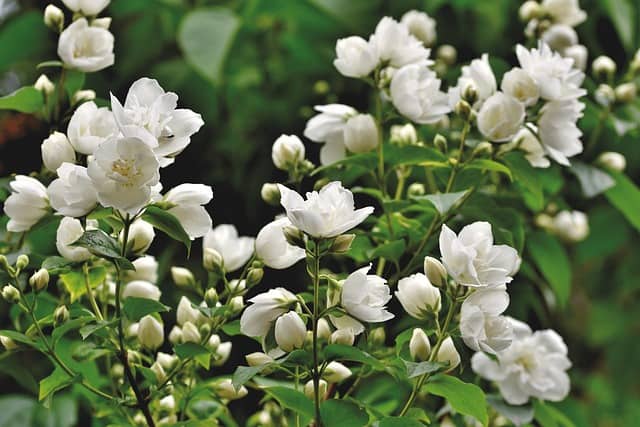This guide will provide you with everything you need to know about successfully propagating jasmine, so you can enjoy its lovely scent in your garden or home.
Understanding Jasmine

Jasmine is a genus of flowering plants in the Oleaceae family, comprising several species, including the popular Jasminum officinale (common jasmine) and Jasminum sambac (Arabian jasmine). These plants thrive in warm climates and are often grown as ground cover, climbing vines, or potted plants.
The sweet, aromatic flowers bloom in summer and are often used in perfumes, teas, and traditional medicines. Depending on the variety, jasmine can be a perennial or, in cooler climates, treated as an annual.
Methods of Propagating Jasmine
There are two primary methods for propagating jasmine: cuttings and layering. Let’s look at both techniques in detail.
1. Propagating Jasmine from Cuttings
What You Need:
Healthy jasmine plant
Sharp, clean scissors or pruning shears
Potting soil or a well-draining potting mix
Small pots or a seed tray
Plastic wrap or a humidity dome
Steps:
Choose the Right Time: Late spring to early summer is the optimal time for taking cuttings, as the plant is in active growth mode.
Select and Cut: Look for semi-hardwood stems—those that are not too soft or too woody. Cut a 4 to 6-inch long section just below a leaf node to encourage rooting.
Prepare the Cuttings: Remove the leaves from the lower half of the cutting. This helps the plant focus energy on root development and reduces moisture loss.
Optional – Use Rooting Hormone: While not essential, dipping the cut end of the stem in rooting hormone can accelerate the rooting process.
Plant the Cuttings: Insert the prepared cutting into the potting mix, making sure at least one leaf node is buried in the soil. Firm the soil around the cutting to provide stability.
Create Humidity: Cover the pot with plastic wrap or place it under a humidity dome to maintain a moist environment, which is crucial for rooting.
Positioning: Place the pot in a warm location with indirect sunlight. Direct sunlight can scorch the cutting and hinder rooting.
Watering: Keep the soil consistently moist but not soggy. Water it lightly, ensuring good drainage.
Wait for Roots: After a few weeks, gently tug on the cutting to check for resistance, indicating root development. Once roots form, you can move the cutting to a larger pot.
2. Propagating Jasmine by Layering
Layering is another effective method for propagating jasmine, particularly for established plants.
What You Need:
Healthy jasmine plant
Scissors
Lightweight soil
Pot or container (optional)
Steps:
Select a Stem: Choose a low, flexible stem from an existing jasmine plant.
Prepare the Stem: Make a small nick in the stem about 12 inches from the tip, just below a leaf node. This will help stimulate root growth.
Bend and Anchor: Gently bend the nicked stem so that the wounded part touches the ground. You can use a small rock or peg to hold it in place.
Cover with Soil: Cover the injured part of the stem with soil, leaving the tip exposed. This section will become the new plant.
Watering: Keep the soil moist throughout the rooting process.
Wait for Roots: Roots will develop from the buried part of the stem, usually within 4 to 6 weeks. Once roots are established, you can sever the new plant from the parent and transplant it to a pot.
Caring for Your Newly Propagated Jasmine

Sunlight: Ensure your new jasmine plants receive plenty of indirect light to foster growth. Once established, they can tolerate more direct exposure.
Watering: Consistent moisture is key. Water when the top inch of soil feels dry but avoid overwatering.
Fertilizing: To encourage robust growth, feed your jasmine plants with a balanced, water-soluble fertilizer every four to six weeks during the growing season (spring and summer). Reduce or stop fertilization in autumn and winter when the plants go dormant.
Pruning: As your jasmine plants grow, periodic pruning will help shape them and promote bushier growth. Remove any dead or unhealthy stems. Light pruning during the blooming season helps improve air circulation and encourages more flowers.
Pest Management: Keep an eye out for common pests such as spider mites, aphids, and whiteflies. If you notice any infestations, treat them promptly with insecticidal soap or neem oil to ensure the health of your plants.
Repotting: As jasmine plants grow, they may outgrow their pots. If you notice that roots are coming out of the drainage holes, it’s time to repot into a larger container. Choose a pot slightly larger than the current one and use fresh potting soil.
Troubleshooting Common Issues
While propagating jasmine is generally straightforward, you may encounter a few challenges:
Slow Rooting: If your cuttings are not rooting after several weeks, consider the amount of light and humidity they are receiving. Increasing humidity with a humidity dome or misting the cuttings might help.
Wilting Cuttings: This may occur due to moisture loss. Ensure your cuttings are adequately covered to retain humidity, and check that the soil is consistently moist.
Yellowing Leaves: Overwatering can cause yellowing leaves, indicating root rot. Make sure your pots have drainage and avoid letting the cuttings sit in standing water.
Lack of Flowers: New plants may not bloom immediately, especially within their first year. Patience is essential, as jasmine often takes time to establish before showing its blooms.
Conclusion
Propagating jasmine can enrich your gardening experience and fill your home with delightful fragrance. By employing these methods of cuttings and layering, you can expand your jasmine collection and share this beautiful plant with friends and family.
Whether you choose to enjoy jasmine outdoors as a sprawling vine or indoors as a delicate potted plant, the joy of seeing your propagation efforts blossom into beautiful flowers is truly fulfilling. So gather your supplies and start propagating jasmine today, and soon you’ll be able to indulge in the enchanting aroma of this beloved plant.





